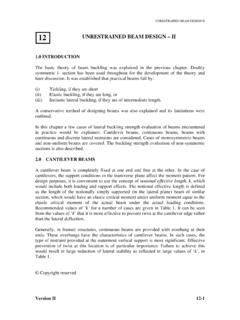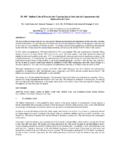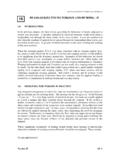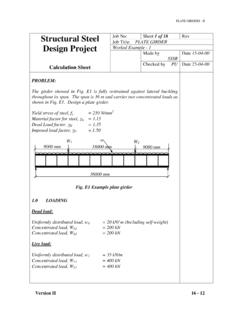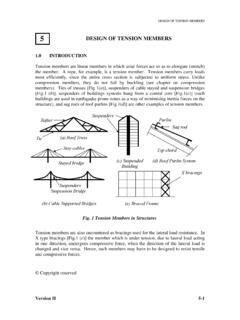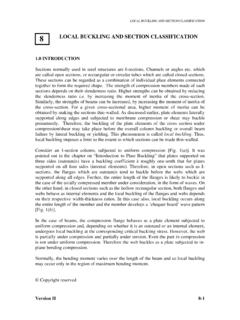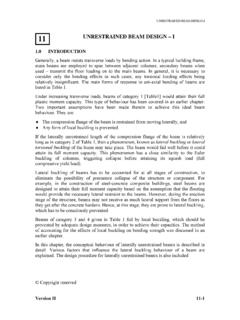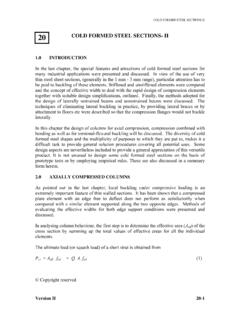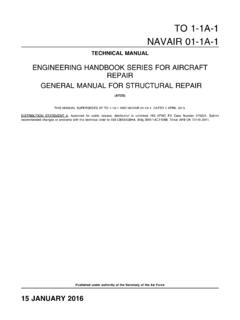Transcription of FABRICATION AND ERECTION OF STRUCTURAL STEELWORK
1 FABRICATION AND ERECTION OF STRUCTURAL STEELWORK Version II 41- {PAGE } FABRICATION AND ERECTION OF STRUCTURAL STEELWORK INTRODUCTION The steel-framed building derives most of its competitive advantage from the virtues of prefabricated components, which can be assembled speedily at site. Unlike concreting, which is usually a wet process conducted at site, steel is produced and subsequently fabricated within a controlled environment. This ensures high quality, manufacture offsite with improved precision and enhanced speed of construction at site. The efficiency of FABRICATION and ERECTION in STRUCTURAL STEELWORK dictates the success of any project involving steel-intensive construction.
2 Current practices of FABRICATION and ERECTION of steel structures in India are generally antiquated and inefficient. Perhaps, this inadequate infrastructure for FABRICATION is unable to support a large growth of steel construction. In India, the FABRICATION and ERECTION of STRUCTURAL STEELWORK has been out of the purview of the STRUCTURAL designer. Nevertheless, in the future emerging situation, the entire steel chain, the producer, client, designer, fabricator and contractor should be able to interact with each other and improve their efficiency and productivity for the success of the project involving STRUCTURAL STEELWORK . Hence it becomes imperative that STRUCTURAL designers also must acquaint themselves with all the aspects of the STRUCTURAL steel work including the FABRICATION and ERECTION , and that is the subject matter of the present chapter to briefly introduce good FABRICATION and ERECTION practices.
3 FABRICATION PROCEDURE STRUCTURAL steel FABRICATION can be carried out in shop or at the construction site. FABRICATION of STEELWORK carried out in shops is precise and of assured quality, whereas field FABRICATION is comparatively of inferior in quality. In India construction site FABRICATION is most common even in large projects due to inexpensive field labour, high cost of transportation, difficulty in the transportation of large members, higher excise duty on products from shop. Beneficial taxation for site work is a major financial incentive for site FABRICATION . The methods followed in site FABRICATION are similar but the level of sophistication of equipment at site and environmental control would be usually less.
4 The skill of personnel at site also tends to be inferior and hence the quality of finished product tends to be relatively inferior. However, shop FABRICATION is efficient in terms of cost, time and quality. STRUCTURAL steel passes through various operations during the course of its FABRICATION . Generally, the sequence of activities in fabricating shops is as shown in Table1. The sequence and importance of shop operations will vary depending on the type of FABRICATION required. All these activities are explained briefly in the subsequent parts of the section. Copyright reserved 41 FABRICATION AND ERECTION OF STRUCTURAL STEELWORK Version II 41- {PAGE } Table 1: Sequence of activities in fabricating shops Sequence of Operation 1.
5 2. 3. 4. 5. 6. 7. 8. 9. 10. Surface cleaning Cutting and machining Punching and drilling Straightening, bending and rolling Fitting and reaming Fastening (bolting, riveting and welding) Finishing Quality control Surface treatment Transportation Surface cleaning STRUCTURAL sections from the rolling mills may require surface cleaning to remove mill scale prior to FABRICATION and painting. Hand preparation, such as wire brushing, does not normally conform to the requirements of modern paint or surface protection system. However in some applications manual cleaning is used and depending on the quality of the cleaned surface they are categorised into Grade St-2 and Grade St-3. blast cleaning is the accepted way of carrying out surface preparation in a well-run FABRICATION shop.
6 Abrasive particles are projected on to the surface of the steel at high speed by either compressed air or centrifugal impeller to remove rust and roughen the surface before applying the coating. By using shot or slag grits, both of which have an angular profile, surface oxides are removed and a rougher surface is obtained to provide an adequate key for metal spraying or special paint. Depending upon the increase in the quality of the cleaned surface, the blast cleaning is categorised into Grade Sa2, Grade Sa2 and Grade Sa- 3. Flame cleaning is another method of surface cleaning. In this method the surface is cleaned using an oxy-acetylene torch which works on the principle of differential thermal expansion between steel and mill scale.
7 In another method called the steel piece is immersed in a suitable acid and the scale and rust are removed. Cutting and Machining Following surface preparation, cutting to length is always the first process to be carried out, and this is done by any of the following methods. FABRICATION AND ERECTION OF STRUCTURAL STEELWORK Version II 41- {PAGE } Shearing and cropping Sections can be cut to length or width by cropping or shearing using hydraulic shears. Heavy sections or long plates can be shaped and cut to length by specialist plate shears. For smaller plates and sections, machines featuring a range of shearing knives, which can accept the differing section shapes, are available.
8 Flame Cutting or Burning In this method, the steel is heated locally by a pressurised mixture of oxygen and a combustible gas such as propane, which passes through a ring of small holes in a cutting nozzle. The heat is focussed on to a very narrow band and the steel melts at 15000 C when a jet of high-pressure oxygen is released through a separate hole in the centre of the nozzle to blast away the molten metal in globules. The desired cuts are obtained quickly by this process. However due to a rapid thermal cycle of heating and cooling, residual stresses and distortion are induced and hence STRUCTURAL sections that are fabricated using flame cutting are treated specially in the design of STRUCTURAL STEELWORK .
9 Arc Plasma Cutting In this method, the cutting energy is produced electrically by heating a gas in an electric arc produced between a tungsten electrode and the workpiece. This ionises the gas, enabling it to conduct an electric current. The high-velocity plasma jet melts the metal of the work piece. The cut produced by plasma jet is very clean and its quality can be improved by using a water injection arc plasma torch. Plasma cutting can be used on thicknesses upto about 150 mm but the process is very slow. Cold Sawing When a section cannot be cut to length by cropping or shearing, then it is normally sawn. All saws for STRUCTURAL applications are mechanical and feature some degree of computer control.
10 There are three forms of mechanical saw - circular, band and hack. The circular saw has a blade rotating in a vertical plane, which can cut either downwards or upwards, though the former is more common. Band saws have less capacity. Sections greater than 600 mm X 600 mm cannot be sawn using band saws. The saw blade is a continuous metal edged, with cutting teeth, which is driven by an electric motor. Hack saws are mechanically driven reciprocating saws. They have normal format blades carried in a heavy duty hack saw frame. They have more productivity than band saws. Punching and Drilling Most FABRICATION shops have a range of machines, which can form holes for connections in STRUCTURAL STEELWORK .
